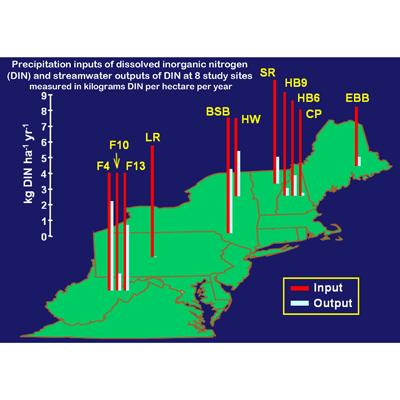A Synthesis of Nitrogen Budgets from 24 Forested Watersheds in Northeastern U.S.

In the northeastern United States, there has been much concern over the impact of elevated nitrogen deposition on forest ecosystems. While forest growth is often limited by availability of nitrogen in this region, there is the potential that increased emissions of nitrogen will result in an excess supply. Excess nitrogen may eventually manifest itself in stream water and have implications for water quality in the region.
Small watersheds have long been recognized as a useful tool for investigating how ecosystems respond to changes caused by both natural and human disturbances. Provided that loss to groundwater is negligible, watershed nitrogen accumulation or loss can be determined by subtracting outputs in stream flow from inputs by atmospheric deposition. NSRC researchers summarized input-output budgets for dissolved inorganic nitrogen for 24 small watersheds in the northeastern United States.
Nitrogen input-output budgets show that watersheds in the Northeast retain nitrogen on an annual basis. Despite this general pattern, there is a broad range in retention values and no obvious relationship with nitrogen inputs in precipitation at this scale. Watershed characteristics such as land-use, water flow paths, and vegetation appear to override simple input-output relationships. Consequently, changes in atmospheric deposition of nitrogen resulting from stricter emissions regulations may not result in changes in stream water nitrogen fluxes. Understanding factors that control nitrogen retention is critical to our understanding of how watersheds will react to future changes in nitrogen deposition. This information will contribute to development of nitrogen deposition policy such as the Clean Air Act, which in part sets target reductions for nitrogen emissions.
